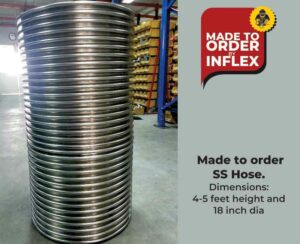The Best Practices for Storing Stainless Steel Hose
Introduction
Storing Stainless Steel Hose-When it comes to industrial and commercial applications, stainless steel hydraulic hoses are a popular choice due to their durability and resistance to corrosion. However, without proper storage, these hoses can be degraded and their life expectancy decreased, not to mention the potential of failure is increased. In this article, we’ll explore the best practices for storing stainless steel hose to ensure optimal performance and longevity.
Store in a Dry and Cool Environment
Stainless steel hydraulic hoses should be kept in a dry, cool area away from direct sunlight and heat sources. Moisture can cause corrosion, while high temperatures can weaken the structure and compromise its integrity. To avoid these issues, store the hoses in a clean and dry area.
Keep Hoses Clean and Free from Contaminants
Contaminants such as dirt, oil, and chemicals can cause damage to stainless steel hydraulic hoses. To avoid this, clean and dry the hoses before storage and use a protective cover or bag to keep them free from dust and debris.
Avoid Sharp Bends and Kinks
Sharp bends and kinks can lead to leaks and failure, so it’s important to store hoses in a way that prevents this from happening. Use hose racks or reels to store them in a straight or gently curved position and avoid hanging them or bending them at sharp angles.
Proper Labeling and Organization
Labeling and organizing the hoses helps to avoid confusion and potential damage. Label each hose with its size, length, and pressure rating and organize them by type and size for easy retrieval.
Regular Inspection and Maintenance
Regular inspection and maintenance can help identify any potential issues with the hoses before they become a problem. Inspect the hoses regularly and address any issues promptly. Cleaning and lubrication are also important for extending their lifespan.
Avoid Exposure to UV Light
UV light can damage stainless steel hydraulic hoses over time, leading to cracking and failure. To prevent this, keep the hoses away from direct sunlight and UV light sources, and use protective covers or bags during storage.
Avoid Contact with Other Materials
Stainless steel hydraulic hoses should be stored separately from other materials like tools and chemicals that may come into contact with them and cause damage. Make sure they’re kept in a designated area away from any risky materials.
Proper Handling and Transport
When handling and transporting the hoses, avoid dragging or pulling them across rough surfaces and use proper lifting and carrying techniques to avoid bending or twisting them. During transport, secure the hoses to prevent them from shifting or rubbing against other objects.
Use the Correct Fittings and Accessories
Using the correct fittings and accessories can help ensure proper installation and performance of the hoses. Make sure the fittings are compatible with the hoses and are tightened to the correct torque specifications. Use protective caps and plugs to seal the ends of the hoses during storage.
Frequently Asked Questions
FAQ 1: How long can I store stainless steel hydraulic hoses?
Answer: Stainless steel hydraulic hoses can be stored for an extended period if stored in the proper conditions. Regular inspection and maintenance is recommended to ensure they remain in good condition.
FAQ 2: Can I store stainless steel hydraulic hoses outdoors?
Answer: It is not recommended to store stainless steel hydraulic hoses outdoors, as they may be exposed to moisture, UV light, and other environmental factors that can cause damage.
FAQ 3: Should I use protective covers to store the hoses?
Answer: Yes, using protective covers or bags can help keep the hoses clean and free from contaminants, and protect them from UV light.
FAQ 4: Can I use any type of fittings with stainless steel hydraulic hoses?
Answer: No, it is essential to use the correct fittings and accessories that are compatible with the hoses and are tightened to the correct torque specifications.
FAQ 5: How often should I inspect and maintain stainless steel hydraulic hoses?
Answer: It is recommended to inspect the hoses regularly, at least once every three months, and address any issues promptly. Regular maintenance, such as cleaning and lubrication, is also important for extending the lifespan of the hoses.
Conclusion
By following the best practices for storing stainless steel hydraulic hoses, you can ensure optimal performance and longevity. This includes storing in a dry and cool environment, keeping clean and free from contaminants, avoiding sharp bends and kinks, and regularly inspecting and maintaining the hoses. It’s also important to use the correct fittings and accessories, store the hoses separately from other materials, and use proper lifting and carrying techniques during transport. With these practices in place, you can keep your stainless steel hydraulic hoses in top condition for many years to come.

